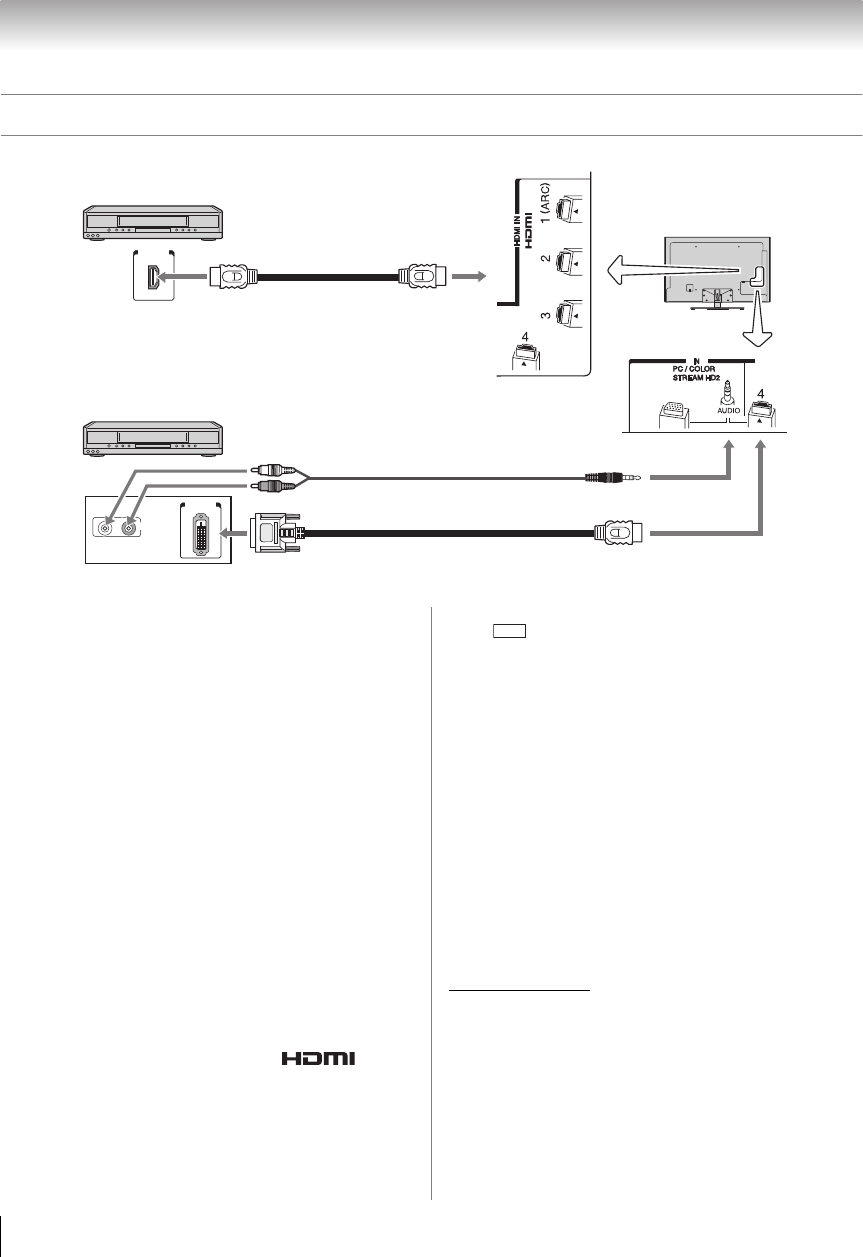
16
Chapter 2: Connecting your TV
Connecting an HDMI
®
or DVI device to the HDMI input
HDMI
OUT
DVI/HDCP
OUT
AUDIO
R
L
OUT
TV back panel
HDMI device
HDMI cable
DVI device
HDMI-to-DVI adapter cable
Analog audio cable
The HDMI input on your TV receives digital audio and
uncompressed digital video from an HDMI device, or
uncompressed digital video from a DVI (Digital Visual
Interface) device.
This input is designed to accept HDCP (High-
Bandwidth Digital-Content Protection) program
material in digital form from EIA/CEA-861-D
compliant[1] consumer electronic devices (such as a set-
top box or DVD player with HDMI or DVI output).
Supported signal formats: VGA, SVGA, XGA, WXGA,
SXGA, 480i (60Hz), 480p (60Hz), 720p (60Hz), 1080i
(60Hz), and 1080p (24Hz/60Hz). For signal
specifications, see p. 76.
Supported Audio format: Linear PCM, sampling rate
32/44.1/48 kHz.
Note:
• For connecting a PC to the HDMI input, see p. 20.
• Some legacy HDMI sources may not work properly with
your HDMI TV due to the adoption of new standards. Try
disabling the options in HDMI Settings. (- p. 41).
To connect an HDMI device, you will need:
•One HDMI cable per HDMI device
– Recommendation: For proper operation, use an
HDMI cable with the HDMI Logo ( ).
– To display an 1080p/60 Hz signal format, you need a
High Speed HDMI cable. A conventional HDMI/DVI
cable may not work properly.
– An HDMI cable transfers video and audio. Separate
analog audio cables are not required.
To view the HDMI device video:
Press and B or b to select HDMI 1, HDMI 2, HDMI
3, or HDMI 4.
Note: For programming the TV remote control to operate
other devices, see p. 79.
To connect a DVI device, you will need:
•HDMI-to-DVI adapter cable
– For proper operation, the length of the HDMI-to-DVI
adapter cable must not exceed 9.8 ft (3 m).
Recomended length: 6.6 ft (2 m).
•3.5mm Stereo to RCA Y-Cable
– An HDMI-to-DVI adapter cable transfers video only.
Separate analog audio cables are required.
Note: To ensure that the HDMI or DVI device is reset
properly:
• When turning on electronic components, turn on the TV
first and then the HDMI or DVI device.
• When turning off electronic components, turn off the
HDMI or DVI device first and then the TV.
[1] EIA/CEA-861-D compliance covers the transmission of
uncompressed digital video with high-bandwidth digital
content protection, which is being standardized for
reception of high-definition video signals. Because this is
an evolving technology, it is possible that some devices
may not operate properly with the TV.
INPUT


















